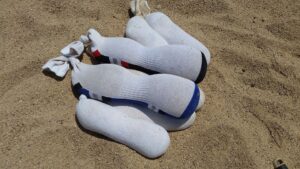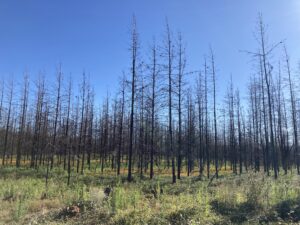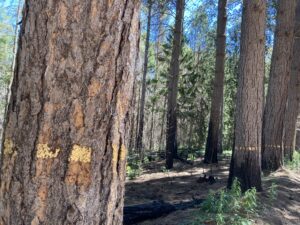A short story for a tall tree
When I was small (and indeed, even now, when I am much less small), some of my favorite stories that my mom would tell me were about her childhood summers in Michigan. She was an only child (still is), but she was friends with a large family, and every summer they would gather up their children, and my mom, and go up north to a lake where the large family had some cabins, and spend time there. Years later, when I was in university at Michigan State, I was startled by how many people had family cabins ‘up North’. Apparently, it is a very Michigan thing.
There’s a similar thing here in Canberra, Australia. We are situated about two hours’ drive from the ocean, and quite a few people have houses down the coast. I believe that in the 80’s, my parents were offered the chance to go in on a ‘beach shack’, a proposal that died as soon as my mom heard that it featured an unattached dunny (basically, an outhouse.) Still, I was always mildly interested by the idea of having some other house that you sometimes spent time in, but mostly didn’t.
All of this is by way of saying that it’s been a few years since I’ve blogged, or done anything with this website, and I always rather think of it as like owning a beach shack. You don’t necessarily spend time there, but it’s yours, and its existence is always in the back of your head. You pay the annual fee (like a beach house mortgage), and guiltily think that you really ought to get more out of it. But then I think “Would you rather have a blog post, or get some more novel written?” and I ponder the question for a moment, and then I proceed to write some more novel.
However, it has been quite a while since I last checked it over, and quite a few things have happened since then. I had a second book come out, and a mini-series was made of The Rook, and I’m resolved to do more regular maintenance of this site. And luckily, I had a good adventure this past week, and thought I would write about it.
It does require a bit of backstory, though.
Now, you may recall that at the end of 2019 and the beginning of 2020, there were some rather gigantic and terrifying bushfires in Australia. Bushfires are a thing here, they’re never good, you never take them for granted, but these were out-of-their-mind big. They didn’t come too close to Canberra (although quite close enough), but the valleys here were filled with smoke for days on end. The sky was orange. Everyone was wearing masks before it became a thing, and air purifiers were invaluable (we did not have one – we kept the windows shut, and sweltered.)
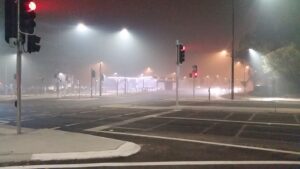
When you live in Australia, you can’t help but absorb a goodly amount of bushfire lore. You’re always well aware that sparks can carry on the wind for miles and miles, glowing softly in the air, floating on a hot breeze, before settling happily on something flammable and starting a new fire. So, even if you’re a long way away from the fires, you’re not safe by any means. Everyone was always on edge, checking the latest news and speculating constantly. When I went to the movies with a friend to see ‘Little Women’, we both kept checking our phones throughout, just in case our houses might be burning down. My house backs on to a nature reserve that has already had some exciting fires in my lifetime, so we made plans for what might happen and what we would do.
If fire DID spring up around us, our plan was to stay and fight for as long as seemed wise and winnable, and then, if it ceased to be wise or winnable, we would get out. This seemed a realistic plan since, although there’s the reserve directly behind us, it is uphill from us, and we’d mowed the nearby grass down short. Also, we do live in suburbia, in the middle of the city, with lots of roads and alternative routes.
So, the first part meant planning for the fight, if it came. The bath tub was filled, and kept filled (although we’d dip water out of it to water the house plants.). Other preparations were made. Apparently, one of the favourite places for bushfires to ignite houses is the rain guttering. It makes sense since, although they’re metal, they tend to gather up leaves and twigs and stuff, all of which get baked by the Australian summer sun until it is ideal kindling.
So, you’re advised to block off the downspouts, and fill the gutters with water. When I researched HOW one blocks off the downspouts, they suggested tennis balls (which we did not have), OR you could make little sandbags out of your socks and sand. So I collected a bunch of odd socks, took them down to the lake, and spent a few happy (if smoky) minutes troweling sand into my socks and knotting them, and musing how many orphaned socks I’d had in my sock drawer. By the end, I had eight little sausages made of sock and sand.
As my mom remarked, “How nice, you’ve made a set of miniature coshes!”
Then, we set about planning the escape, if it came to it. I purchased some little walkie-talkies for the two cars, and put a twelve-pack of bottled water in each trunk. Our initial plan was that we would head to the local playing field, and camp out there. Back in 2003, when we’d had to evacuate our horse off the local paddocks because of… you guessed it… bushfire, my mom and her friend had taken their horses to the local playing fields and spent the night in the cricket nets (it all worked out quite well, until the sprinklers came on at 3AM and soaked them.)
I wrote up our bushfire escape list, all the things that we would want to take with us. This is especially important, because when you’re confronted with immediate evacuation, it’s apparently difficult to think calmly and strategically. When I watched the documentary ‘The Biggest Little Farm’, there’s a scene when they have to evacuate their farm in the face of wildfires, and when they look at what they grabbed to take with them, it’s an array of odd things. A Yoga mat. A book that they hadn’t read in years. That sort of thing.
Of course, the book they hadn’t read in years was entirely something we would take – the O’Malleys do not do well without something to read – but we at least wanted to be strategic about which books we would take. In fact, it was decreed we would each be allowed to take only a single box of books. Of course, then you ask yourself if you take the books that are most expensive, the books that would be the hardest to replace, or the books that you want to read next. I opted for the books I wanted to read next (I was working my way through all of Jonathan Hickman’s work at Marvel Comics, and would remove books from the ‘save’ box as soon as I’d finished them, and replace them with the next book in the To-Read Pile).
But it wasn’t just books, of course. We each had a go bag with three days’ worth of clothes, and important documents (passports, etc.). Also, a list of things we’d want, ranging from a copy each of my novels, my dad’s dissertation, photo albums, dog food, dog bed, toiletries, dog, phone charger, laptop (I’d already emailed my latest manuscript to myself, so that Google would look after it), hard drive, medications, etc. It wasn’t that much stuff, actually, and the plan was that once it was loaded in the cars, we’d put the back sets down, and layer in as much art as we could fit.
In the end, we felt pretty well prepared.
And of course, it didn’t prove necessary in the end, not for us. Fires came close, but they didn’t reach us, and the only lasting problem for us was my discovery that they hadn’t been odd socks, and that since I was unwilling to dismantle my mini-sandbags (they’re still draped lumpily over the ladder in the garage), I would need to wear mismatched socks for months on end.
During that time, however, I had been glued to the Facebook feed of my friend, Sulari Gentill. Sulari is also a novelist, we met years ago at the Snowy Mountains Book Festival, and I really enjoy her stuff. My favourite is her ‘Rowland Sinclair’ series of historical murder mysteries beginning in late 1930’s Australia. Sulari and her family live on a farm just outside the mountain of Batlow, in New South Wales. Batlow is famous for its apple orchards (and for Sulari), and it’s really a nice place. It climbs up the slope of a mountain, and you can look across vast valleys to see mountains, on the other side of which is my home town. I had visited there previously for the Batlow Literary Festival, which was masterminded by Sulari, and liked it very much. But the fires were a nightmare there. At the same time that I was filling socks with sand, there were gigantic conflagrations that consumed vast swatches of bushland and pine forest.
Sulari’s husband and one of her sons are volunteer firefighters, and while they were defending the town, the fires were roaring towards their house. At one point, there was word that the house had been consumed – it later turned out that the observers had been deceived, that it was the sheds by the house (and I mean RIGHT by the house) that had gone up in flames. The house survived, shielded by chance and by trees that bore the brunt, although their guttering bubbled from the heat. The whole thing was a nightmare, but they came through it.
https://www.nytimes.com/2020/01/09/world/australia/fires.html
A few months ago, Sulari and I were chatting on the phone, and she asked if I’d like to be involved in a project for the Pilot Hill Arboretum. Founded in the 1920s, and nestled in the Bago State Forest, the arboretum came through the fires with only some damage. That may sound facile, but the area around it was utterly blasted, including the Sugar Pines Walk, which has been described to me as ‘a magnificent cathedral of trees.’
The arboretum’s survival was practically miraculous, and in order to celebrate it, and to commemorate the anniversary of the fires, there was to be an Arbor Festival, which would include art installations among the trees. Sulari was overseeing one of the projects, and would I be interested?
You bet I would.
The project was this: A selection of writers would each be assigned a specific tree in the arboretum. They would write a short story for the tree, about the tree, and a local performer would record the story. Then, if you’re visiting the arboretum, you can use the appropriate app to hear the tree tell you the story. I knew some of the other writers, including Robert Gott, Karen Viggers, and Kaaron Warren.
I was given the arboretum’s Sequoiadendron giganteum, also known as the Giant Redwood or (and this is my favorite) ‘Big Tree’. I had about three thousand words in which to tell a story, which was a bit difficult for me because (and you may have noticed this) I do tend to go on a bit. Plus, while trees are beautiful, they don’t necessarily lend themselves towards being the most dynamic of protagonists. Still, I hammered out something I was rather pleased with, and sent it off to Sulari. Later, I got word that the whole thing has been installed successfully, and was very happy with the idea of people sitting by a Giant Redwood and having it tell them a story of discovery and violence and hate and magic.
And then Kaaron Warren, who also lives in Canberra, and I met to catch up and gorge on Chinese dumplings. Kaaron writes all sorts of great stuff, but I really enjoy her horror – it’s genuinely frightening. In between soup dumplings and the fried combination, we remarked how we should go descend upon Batlow (or ascend, I suppose, since it’s up higher than Canberra), and bother Sulari, and check out how our stories played in the wild. The Australian Capital Territory (Canberra’s little Vatican City of a territory that is held entirely inside the state of New South Wales) was (and currently is) free of Covid, and so we would be able to drive to Batlow without any problems.
So we made plans, warned Sulari, and a few days later I filled the car’s tank with petroleum distillate, my mom made us a bag of snacks, and we set off out into the New South Welsh countryside.
Thanks to Covid, this was my second time out of Canberra in over a year (the other had been to the city of Goulburn, which is about an hour away). The key to any successful road trip, of course, is to set down the arrangements beforehand. Kaaron and I agreed that we would stop if either of us needed the bathroom, wanted a beverage, or saw anything that we wanted to investigate more closely. Fortunately, we share a very similar taste in things that needed investigating. We paused in the (according to Wikipedia) ‘locality’ of Jugiong and, as one, agreed that we should check out the cemetery, which really does feel like a place of eternity. Lots of beautiful old tombstones, sometimes showing multiple generations of the same family, and some enclosures with the wrought iron fences rusting away under the blinding summer sun.
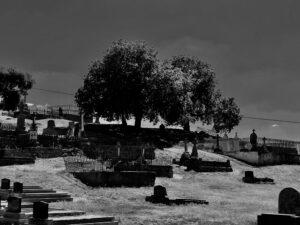
One recent grave had a feature I’d never seen before: a pair of hashtags, so that visitors were directed to a Facebook page about the deceased person. I like the idea, and I enjoy wondering what future archaeologists (whatever species they are) will make of them.
Driving up the hills and into the mountains towards Batlow, we could see signs of where the fires had been. It’s been long enough that the grass is recovered, but coming out of the green, there were acres and acres of burnt dead trees. We also saw unburned apple orchards, with hundreds of square metres of white shade cloth spread over them.
Batlow was looking good when we passed through it. I was especially glad to see the very handsome Batlow Literary Institute building, which I knew from the Literary Festival. I don’t know if all small towns have a literary institute – I certainly hope so – but it’s a wonderful thing to be there.
We fell upon Sulari with open arms, and in short order, she was driving us out to the National Park. We could see more signs of the fires – the eucalypts that had survived were practically bursting with greenery which had erupted all up and down their trunks. Sulari explained that it was ‘panic growth’, and wasn’t necessarily a sign that the trees would live.
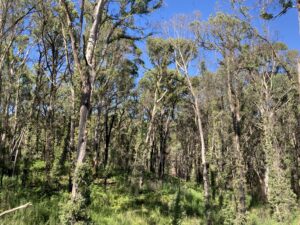
When we came to the Park, it was heartbreaking. I’d looked it up previously, and what had once been forest was open, now. Like we’d seen before, greenery covered the ground, but it was like an old battlefield, with the dead trees piled about where they had fallen. There were stands where scorched tree trunks, months dead, still stood in rows.
Periodically, we would pull over to the very edge of the rough dirt road when a gigantic truck hauling tree trunks would approach, throwing up a massive cloud of dust.
When we came to the arboretum, it was startling to see living, green, lush trees. Some of the trees had been painted with a thin strip of gold paint as part of the festival – an installation designed to evoke ‘Kintsugi’, a practice in Japan of repairing cracked items with gold dust and resin, to acknowledge the history of the item.
The trees didn’t stand in their own little isolated plots like a museum – they were part of the forest, and you needed to find their little plinths with plaques to learn what you were looking at. Otherwise, it was exotic trees folded almost secretly into the scenery.
With folding chairs, and wine, we tromped over to the tree that Kaaron had been assigned – the Japanese larch – and opened the app to hear the tree to tell its story.
Now, I’m not generally one for being read to. I read very quickly, so being read to doesn’t work for me. And I also read while walking (which has only occasionally led to disaster), so audio books aren’t something I partake of. But sitting back and staring up at a tree as a story of that tree is told to you is a very engaging experience. And if it’s a scary story (as this one is), then every call of a bird, or creak of a trunk in the background, serves to send that extra shiver up your neck.
From there, we moved to another tree, and listened to the story written by another Canberra-based novelist and friend, Karen Viggers. Let me tell you, Karen knows how to write a story about the Australian landscape.
And then we came to my tree – Big Tree. And if you think that name is a little simplistic, well, it is undeniably a very big tree.

I don’t want to talk too much about my story, but I’ll give you the opening lines:
I wasn’t always planted here.
And I wasn’t always a tree.
I will say that the lady who performed the story did an outstanding job, and really brought a very vivid interpretation to it. I was delighted.
From my tree, we ambled on up to the elm, which was undeniably the most beautiful tree we saw. This was the one that had been assigned to Robert Gott, who I had met at the literary festival, and whose books I promptly devoured. Robert writes murder mysteries with a wicked sense of humour, and so I had taken care to find out which tree he got, and then made it the villain in my story, which I thought he would approve of.
I don’t recall what type of tree Sulari had written for, but she had bagged an extremely majestic one, and then written it a story that tied in crime, love, the bushfires, and the history that the tree had witnessed. Really nice.
Unfortunately, we did not have enough daylight (or wine) to listen to every tree. However, the installation is going to be present for an entire year, so I am returned to resolve, and listen to the rest. And I would recommend that you do the same, if you get the opportunity.
Of course, there’s lots more to talk about, and I’m sure that you may be wondering about the progress of my next book, and if it’s a Checquy novel.
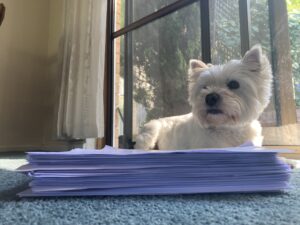
It IS progressing, and it IS a Checquy novel. Work is still being done on it, but as soon as I have a release date, I shall broadcast it from every avenue. And in the meantime, I’ll be endeavouring to be a more frequent blogger.
A short story for a tall tree Read More »
